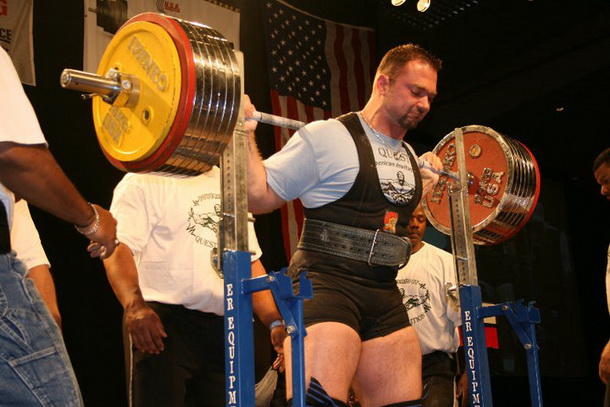The Priority Continuum
Consistency: Are you training often enough?
Frequency: Are you training your T1 movements frequently and consistently?
Volume: Are you programming with adequate volume in all tiers, frequently and consistently?
Intensity: Are you moving intensities with adequate volume in all tiers, frequently and consistently?
Diet: Are you adhering to a diet that guarantees your continued performance in the above four?
Drugs: Are all above matters in order?
But why in that order? Ultimately I decided to put them in that order because if you don't have the proceeding value in place then the following one is less effective. This I believe to be true for all training methods, programs, and whose-its and whats-its.
This baby took steroids once and now
he can bench your squat.
Don't get me wrong, you could take steroids, never workout, and gain muscle. The gist of that study is that over the course of 10-weeks guys given weekly injections of 600mg testosterone enanthate and not working out gained seven pounds of muscle while the guys working out and not receiving testosterone injections gained around four pounds. The guys working out and on test? How does nearly 13.5 pounds of lean mass sound?
From the study:
"Fat-free mass did not change significantly in the group assigned to placebo but no exercise. The men treated with testosterone but no exercise had an increase of 3.2 kg in fat-free mass, and those in the placebo-plus-exercise group had an increase of 1.9 kg. The increase in the testosterone-plus-exercise group was substantially greater (averaging 6.1 kg). The percentage of body fat did not change significantly in any group (data not shown)."
I want to be absolutely clear that this order in no way assumes that you cannot have one without the other or that the order needs to be perfect before moving onto the next step. It is merely how I prefer to prioritize my own training, and my general training philosophy. My argument is that without following them in that order the next step in simply less effective.
Consistency
The easiest one. Without consistent attendance in the gym on a regular schedule then none of the following can be developed to their maximum potential. It takes regular attendance in the gym to see the desired results. When I talk about consistency I'm referring to making it to the gym to train weekly. Every strength athlete or bodybuilder trains on at least a weekly basis. In my search to find those who do not, I've not seen or heard, or read about, any that train less than 1x per week.
Frequency
The next step. How often are you training your main movements? The lowest lift frequency I have ever read about, by anyone notable, is from Stan Efferding. From this interview:
"I trained twice a week when I hit my 2,303 pound raw total
and set the all-time world record.
I would bench on Mondays and squat OR deadlift on Saturdays.
Wednesdays was stretching, balance and core work. That’s it!"
- Stan Efferding
So there you have it, if you are Stan Efferding, then you can train hard 2x per week. You can bench once a week for a month and deadlift or squat every other week. It would also be stupid to think that is how he has trained his entire life. And guess what, you're not Stan Efferding, and that's why I'm suggesting that at a minimum the main movements are trained weekly.
Some examples of novice programs:
Some examples of novice programs:
Squat (3x per week)
Bench (1-2x per week)
Press (1-2x per week)
Deadlift (1x per week, alternating)
Power Clean (1x per week, alternating)
Squat (2x per week)
Bench or Press (3x per week)
Deadlift (1x per week)
Squat (3x per week)
Bench (1x per week) *Maybe 2x if you want to count incline.
Power Clean (3x per week)
Admittedly, the first two novice programs are essentially built upon Bill Starr's programs. But even the most illustrious Scooby has 3x per week lift frequency! And his is the most popular and about as far away from "traditional" strength or bodybuilding programs I could find.
Silly Hats: Three Sets, Eight Reps
There is a reason why novice programs have a high lift frequency. It all boils down to practice. You have to practice the movements to get better at them. If you lack experience in a movement then no amount of strength is going to make you great at it. Sure, you might be able to do it, but it could be done better with more frequent practice. Or, you might almost decapitate yourself.
There is a reason why children in elementary school practice their fundamental skills- math, reading, and writing on a daily basis. The more important the skill, the more frequent practice should be at the beginning of its mastery. And just like being in school, frequency in training can begin to lessen as progress occurs.
Decreasing lift frequency however may not be a great way to train. If anything, training your main movements multiple times per week may be more beneficial, even for advanced athletes.
From my own training experience the only lift I have ever trained less than 1x per week and still saw improvement on was my deadlift. That I attribute to me squatting 3x per week and training my upper back another 2x per week. But as the 2012 IPL Worlds was about a month out I certainly increased my deadlift frequency to 1x per week. Admittedly it did go nearly two months without frequent training.
Frequency means practice and practice means skill development. The more difficult the skill, the more frequent the practice. It should be said that knowledge of performance, or feedback, of your practice could be potentially harmful. So that means get in the gym and practice your lifts and don't worry so much about the finer nuances at first as that may result in subpar performance.
Moving ahead is where things begin to get... argumentative.
Volume
I put this one before intensity for a few reasons.
1. Volume builds muscle. Muscle lifts weights. Bigger muscles have a greater capacity for moving more weight.
2. Volume means bar lifts. Bar lifts means practice. The more a movement is performed the more the skill is increased. The greater the skill, the greater the transference of strength.
3. Volume builds capacity. Capacity means the ability to handle an increased workload which translates into a greater ability to recover. And thus the greater ability to practice more often.
When I say volume I'm not talking about German Volume Training specifically. So don't confuse the term "volume" with meaning near endless reps of squats until either your heart explodes or your legs require amputation. I'm simply talking about performing enough repetitions per training day to warrant the desired results. Obviously with GVT the desired results are hypertrophy. If the desired result is moving a heavy weight then the required volume is much less.
No one ever became a great squatter by going into the gym and doing a single then leaving. That's taking the volume argument to the extreme but point still stands that volume means practice and coupled with frequency it results in greater skill development.
But how much volume?
This much:
Taken from my original GZCL Method.
If someone were to perform the greatest quantities suggested, within each range, then that would result in 75 bar lifts in a single training day of their main movement. To some that might sound like a lot. But what if I broke it down like this:
Squat (Training Max is 405 lb.)
Bar x10 rep x 3 sets
95 lb. x5 rep x 2 sets
135 lb. x3 rep x 2 sets
225 lb. x1 rep x 1 set
315 lb. x 1 rep x 1 set
Warm Up complete (T3@<65% 47 reps, total 48) *315 is in T2 intensity range.
345 x3 rep x5 sets (T1@85%. 15 reps completed, total 63)
265 x5 rep x4 sets (T2 @85%. 21 reps completed.)
Total squats performed: 83
(That's actually how I warm up for squats.)
That is barely more than the greatest quantities suggested at the minimum intensities of each range. Now for me, that would not constitute a complete workout. I would maybe do another T2 movement and also perform at a minimum one or two T3 accessory movements, like GHRs, good mornings, or leg curls and extensions. Each with their appropriate volumes and intensities.
Some would argue that the warm up reps "don't count." But I am adamant that they do. Moving a weight regardless of the quantity should be done with focus, intent, and force. And producing force means effort, and whenever you put a great amount of effort into something, it certainly counts.
"I think it's fairly obvious that in most sports endeavors
you'd like your force output to be as high as possible."
- Fred "Dr. Squat" Hatfield
Nearly every type of programming variation, whether it be linear, block, conjugate, undulating, or wave can accommodate such volume in the main lifts. In some of those you may not be training in each of the 3 Tiers as I suggest, but at lower intensities they often require the lifter to perform more repetitions.
Take for instance the classic, tried and true, block periodization model which has a lifter performing a greater number of repetitions, with perhaps multiple lift variations, during the accumulation phase with lower intensity (within the T2 range) then they move onto the transmutation phase with slightly less volume and slightly more intensity (T2, possibly some T1), then lastly they move into the realization phase where the intensity is high and the volume now low (T1 range).
Even within conjugate, undulating, or wave training systems most lifters are performing around 75 bar lifts of their main movement, or a number of its variations, per workout. The only exception may be linear progression formats which are commonly catered towards novice trainees. Their recovery is lessened because of their novice status, and thus their volume should be low so as to prevent excess fatigue as a result of a lower work capacity.
To wrap up the volume segment, volume means hypertrophy and skill practice. Big muscles and practice means increased strength and skill development. Better skills and strength mean greater force application to the bar. And the more force you can put into the bar, the more weight you can move.
Just ease yourself into higher volume training if you don't have the capacity to recover from it.
Otherwise this will be you.
Intensity
Generally speaking intensity is all about how hard you push yourself. In weightlifting and powerlifting specifically it is about how much weight is on the bar. But lets consider a scenario outside of those two sports, but something I hope we all can still relate to- sprinting.
What happens when a person who doesn't sprint much goes outside for a few rounds of 50m sprints? Well, what is likely to happen is an injury to the quadricep, or more often, hamstring. Why is this? Because their body is not accustomed to that type of intensity. Even with collegiate athletes their sprint training often follows a periodization of distance at lower intensities then ramping up to greater speed and acceleration training. (Warning .pdf)
The same thing happens with intensity in powerlifting and weightlifting. Without adequate practice the bar path is inefficient which results in a lower intensity threshold. With less practice also comes a greater risk of injury at lower intensities.
There is also a reason why both the block periodization and conjugate training styles have lifters gradually working up to a maximal effort. In the latter they are absolutely doing it more frequently, in greater variations, but none-the-less they are still working up to a max. And in that work, they are accumulating reps, or volume, in that lift.
In the popular Westside template (Warning .pdf) they are performing a single day of max effort work (T1 range) supplemented by both dynamic and repetition work on another day. Even the guys who are training with a template notorious for maximal work use reps to build their intensities upon.
However it is the Bulgarians who are most known for max effort work, and athletes working in this template always work into the T1 range, sometimes perform some back off sets then go home. A simple to understand write up can be read here. The key take away is that because of their high frequency the lift volume remains high, but spread across many days, and thus their ability to handle daily maximums is increased. A great quote taken from that article,
"This means you are going to really need to
pay attention to your warm-ups and cool-downs."
- Jacob Tsypkin, JTS Strength
I suppose that quote goes back to what I said above. Warm up reps count. Give them the credence they deserve. Build your capacities for intensity upon your capacity for volume.
Do not get me wrong, I am a huge advocate for training intensity and doing it frequently. If it were up to me I would have everyone hitting a handful of reps in that 85% or more range every single training session in one of their main movements. My biggest reasons for this:
1. Frequency of intensity training builds intensity capacity.
2. Always training a main movement with T1 intensities builds confidence under the bar. Which then translates into greater success in the gym and on the platform.
That last one is especially important to understand. Taken from who I consider to be the smartest man in the game, Mike Tuchscherer:
"Peak force production is tied to the weight on the bar. Are you trying to maximize force? Add weight. In real life, you won’t be able to accelerate enough to produce force like you can in a max lift. No way around it. Sure, a set done with maximum acceleration will produce more force than one done with an even tempo. But only if the weight on the bar is similar. If you always accelerate maximally, you will produce more force if the weight on the bar is heavier, even though acceleration is less."
If you want to be strong you have to create force. If you want to create force you must lift with intensity. Acceleration and "speed work" is great and all, but you simply cannot move fast enough to match the same amount of force produced by moving a heavier load. And like Dr. Squat said in an article I posted above, lifters should always be trying to move the bar as fast as they can. Regardless of the weight, regardless of where they are in the range of motion.
Great strength cannot be built without getting some reps in that T1 range. Ten is all I'm asking for, and that's not all that much.
One more piece why I put volume before intensity, injuries. They are caused by two actions: repetitive stress or catastrophic events. The first one can identified, prevented, and/or remedied. It is caused by volume. Thus the term repetitive. The second one however is instantaneous, has no forewarning, and has no resolution until after the fact. It is most often caused by intensity.
Perfect example of a catastrophic injury.
But not all catastrophic injuries are avoidable.
Diet
This is where people will lose their minds about intolerances, meal timing, nutrient break downs, natural, organic, gluten-free, and a litany of other beliefs about what goes in your mouth. Unless you have an allergy, guess what, if you're not training doing the above four your diet doesn't matter all that much in the grand scheme of things. The impact of whether or not you eat breakfast will be negligible if you are training every other full moon and squat less frequently than Nathan Poage benches.
I have one saying that encompasses "dieting."
Want to gain weight? Never be hungry. Want to lose weight. Sometimes be hungry.
It is pretty damn simple really. It all boils down to calories in vs calories out. There are so many methods to gaining and losing weight that they rival the number of hotdogs consumed annually by Kobayashi.
To think that following a gluten-free diet is going to make a night and day difference in your training when your programming consists of bench press and dumbbell curls superset with text messages and trips to the water fountain, would be asinine. Get everything preceding in order then worry about what goes in your pie hotdog hole.
But diet is the key to taking your training to that next level. There is a reason why damn near every powerlifter in a weight class is insanely lean. They are maximizing the amount of muscle they carry, because although fat adds mass and thus can help leverage it is passive towards actually moving the weight. Whereas muscle can create force.
A proper diet can help bring that muscle to fat ratio more in your favor than a person with a similar training protocol without a good diet. Additionally there may be some foods that you may not even know are causing a hindrance to your training. Being even gluten sensitive can cause increased inflammation, which then causes pain, which will put a stop to even the greatest program; should one ever exist.
Perfect program? For 18 easy payments of $99
this guy can get it to you. Scientists hate him.
But, without self experimentation a lifter wouldn't know that their daily $5 footlong is actually hurting their performance. That is why I'm an advocate of dietary exploration. You must find what works for you. And like all things experimental you should not just jump off the deep end and eliminate every potentially harmful food. Start with one thing, say dairy and evaluate how you feel in a four week span. Do you feel better? Or no different at all? If you feel better, keep it out and maybe try eliminating gluten. Keep following that process until you have identified what foods you can eat while still feeling good.
This same can be said for macro nutrients. Some people can work great on a low carb or ketogenic diet for a long period of time. Namely, Jamie Lewis, who is a massive advocate of that type of dieting protocol. I personally follow it when I'm trying to cut weight for a meet, as it works great for me in short durations. There are others who cannot sustain this type of dieting. If a person suffers from gout then they should probably be eating a diet low in animal proteins, low in saturated fat, and low in fructose. They'll be getting most of their protein from plant sources and will be eating plenty of complex carbohydrates for energy.
The Predator Diet by Jamie Lewis
*traps not included. Link NSFW.
Those are just two vastly different dietary protocols, and guess what, neither of them are wrong.
The lesson is that diet is, and should be, tailored for the individual. Some will respond well to high carb diets, some to high fat ones. Regardless of how you diet, taking your diet seriously is the next step in becoming a greater strength athlete. Whether or not you want to gain or lose weight, recomposition, or simply feel better, knowing how much and what is going in your mouth is the next step in the process.
And like I said before, it matters naught if your training is frivolous.
This also encompasses dietary supplements. Do you know why they're called supplements? Because they are supposed to supplement an already decent diet. If you're eating Big Macs and drinking a liter of cola everyday for lunch then hardly picking at some broccoli and maybe having some spaghetti your mom made you for dinner no amount of protein shakes and NO Explode will pack on the muscle.
Enough said.
Drugs
Now because I have no personal experience and limited second hand knowledge with steroids, pro-hormones, peptides, growth hormone, or insulin use, I will leave this portion short.
It is my personal belief that if your training is inconsistent, lifts infrequent, and you barely lift while eating worse than a mid western scooter confined mother of fifteen- then performance enhancing drugs are probably not the best course of action for you.
Don't confuse that with me saying they are wrong for everyone or that they are ineffective. It is a personal choice, much like drinking, smoking weed, etc.
Is gamma radiation a steroid?
But when discussing training, and how to train effectively to get to the greatest potential, then these are the icing on the cake. The cherry on top of the sundae. It will make everything just that much better. If however, your cake is made like shit, the icing isn't going to pretty it up too damn much. Likewise, what the hell is an ice cream sundae if it is just a cup with a single cherry in it? It's a let down and a damn waste of money. That's what it is.
Another reason I put this at the end is that it comes down to discipline. If an athlete is disciplined enough to follow a consistent and well put together training plan, and then adhere to a diet, they are probably intelligent and diligent enough to do the necessary homework on how to safely and effectively use performance enhancing drugs.
Dat dere CellTech.
Yeeeeaaaaaaaahhhhhhh Budddddddddyyyyyy!!!!
Going back to what I said at the beginning of this tome in reference to the effectiveness of steroids- I'm not saying that training hard and dieting will yield greater results than taking steroids. The complete opposite is true, in fact. I know this. I've accepted it. But that same study showed that taking steroids and actually training yields the greatest results.
If you're taking steroids you would probably want great results too.
My position is simple. If a person is disciplined enough to get all things before drugs regarding their training in order, then going to drug enhancement is the next logical step in the process if they want to become one of the truly elite strength athletes, or bodybuilders; the kind the history books are made of.
And there you have it.
The Priority Continuum: Consistency>Frequency>Volume>Intensity>Diet>Drugs
Why? Because explosions are badass.





























